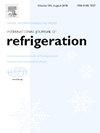Enhanced heat transfer and flow dynamics in liquid helium-free MRI cooling devices: A physical-based modeling approach
IF 3.5
2区 工程技术
Q1 ENGINEERING, MECHANICAL
International Journal of Refrigeration-revue Internationale Du Froid
Pub Date : 2025-06-30
DOI:10.1016/j.ijrefrig.2025.06.037
引用次数: 0
Abstract
Cryocooler contact cooling methods partially mitigate the challenges of liquid helium use in medical Magnetic Resonance Imaging (MRI), where resource constraints and costs are critical. However, these systems still face challenges, including mechanical vibrations, limited cooling capacity, prolonged pre-cooling times, and thermal overload originating from copper leads. This study presents a liquid helium-free MRI cooling device that maintains a temperature of 4 K through natural convection in a helium circuit. A three-dimensional multi-physical model was developed to investigate cool-down times for both single and double pipe configurations and to quantitatively assess their thermal performance. The cooling process was optimized by varying pipe diameters and the integration of copper foam inserts. Increasing porosity and particle diameter significantly reduced cool-down time. The single pipe device achieved a 25 % reduction in cool-down time (from 40 h to 30 h), while the double pipe configuration showed a 72.5 % decrease (from 40 h to 11 h). As the pipe diameter increased from 5 mm to 45 mm, performance markedly improved. The double pipe device’s cool-down time dropped from 38.1 h to 11.3 h (70.1 % improvement), and the single pipe device reduced from 395.7 h to 13 h (96.7 % reduction). To further enhance heat transfer and minimize vortex formation, baffles were introduced, resulting in a significant improvement in the cooling efficiency of the 40 mm diameter single pipe device. Increasing the bottom baffle length (D2) led to 60 mm reduced the cool-down time by 28.7 % matching the performance of double pipe configurations. This optimized design and the developed models provide a framework for advancing sustainable, cost-effective liquid helium-free MRI systems.
增强的传热和流动动力学的液氦核磁共振冷却装置:一个基于物理的建模方法
低温冷却器接触冷却方法部分缓解了液氦在医疗磁共振成像(MRI)中使用的挑战,其中资源限制和成本至关重要。然而,这些系统仍然面临着诸多挑战,包括机械振动、冷却能力有限、预冷却时间过长以及铜引线引起的热过载。本研究提出了一种无液氦核磁共振冷却装置,该装置在氦回路中通过自然对流保持4 K的温度。开发了一个三维多物理模型来研究单管和双管配置的冷却时间,并定量评估其热性能。通过改变管径和泡沫铜嵌套的集成来优化冷却过程。增加孔隙度和颗粒直径可显著缩短冷却时间。单管装置的冷却时间减少了25%(从40小时减少到30小时),而双管装置的冷却时间减少了72.5%(从40小时减少到11小时)。当管径从5mm增加到45mm时,性能显著提高。双管装置的冷却时间从38.1 h降至11.3 h(提高70.1%),单管装置的冷却时间从395.7 h降至13 h(降低96.7%)。为了进一步加强传热和减少涡流的形成,引入了挡板,使直径40 mm的单管装置的冷却效率得到了显著提高。将底部挡板长度(D2)增加到60 mm,与双管配置的性能相比,冷却时间缩短了28.7%。这种优化的设计和开发的模型为推进可持续的、具有成本效益的无液氦MRI系统提供了一个框架。
本文章由计算机程序翻译,如有差异,请以英文原文为准。
求助全文
约1分钟内获得全文
求助全文
来源期刊
CiteScore
7.30
自引率
12.80%
发文量
363
审稿时长
3.7 months
期刊介绍:
The International Journal of Refrigeration is published for the International Institute of Refrigeration (IIR) by Elsevier. It is essential reading for all those wishing to keep abreast of research and industrial news in refrigeration, air conditioning and associated fields. This is particularly important in these times of rapid introduction of alternative refrigerants and the emergence of new technology. The journal has published special issues on alternative refrigerants and novel topics in the field of boiling, condensation, heat pumps, food refrigeration, carbon dioxide, ammonia, hydrocarbons, magnetic refrigeration at room temperature, sorptive cooling, phase change materials and slurries, ejector technology, compressors, and solar cooling.
As well as original research papers the International Journal of Refrigeration also includes review articles, papers presented at IIR conferences, short reports and letters describing preliminary results and experimental details, and letters to the Editor on recent areas of discussion and controversy. Other features include forthcoming events, conference reports and book reviews.
Papers are published in either English or French with the IIR news section in both languages.

 求助内容:
求助内容: 应助结果提醒方式:
应助结果提醒方式:


